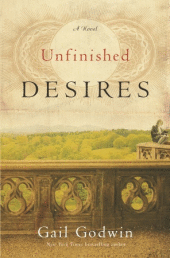Unfinished Desires begins in 1951 at Mount St. Gabriel's, an all-girls school in the North Carolina mountains. Two students form a friendship that fills a void for both of them but also sets in motion a chain of events that profoundly affects the course of many lives --- including the girls' young teacher and the school's matriarch, Mother Suzanne Ravenel, who fifty years later reflects on one pivotol night to try and reconcile past and present. Click here for a discussion guide.
 Of my thirteen novels to date, two have been inspired by places that haunted me, places that were in themselves characters. The first place was the deep countryside of Stone Ridge, N.Y., which became the village of "Old Clove" in The Finishing School. The second was an 84-bedroom rambling Victorian structure set on a hill in Asheville, N.C., which had been a mountain resort in the 1890's, then a tuberculosis sanitarium, and later an orphanage before it became St. Genevieve-of-the-Pines, the school I attended through ninth grade, which became the "Mount St. Gabriel" of Unfinished Desires.
Of my thirteen novels to date, two have been inspired by places that haunted me, places that were in themselves characters. The first place was the deep countryside of Stone Ridge, N.Y., which became the village of "Old Clove" in The Finishing School. The second was an 84-bedroom rambling Victorian structure set on a hill in Asheville, N.C., which had been a mountain resort in the 1890's, then a tuberculosis sanitarium, and later an orphanage before it became St. Genevieve-of-the-Pines, the school I attended through ninth grade, which became the "Mount St. Gabriel" of Unfinished Desires.The staying power of any novel I am writing depends on an intriguing mix of characters who will change one another for better or for worse, and in the process change me: the cerebral couple and the husband's silent child in The Perfectionists; the widow and her two grown daughters in A Mother and Two Daughters; the lonely fourteen-year-old girl and a middle-aged brother and sister in The Finishing School; the two oddly-matched couples in The Good Husband. Usually, their desires and dreads come first, and then they settle into their landscapes. But with both The Finishing School (1984) and Unfinished Desires (2010) the setting bided its time until I found the right cast of characters to live in it.
When I was in my mid-teens, I first tried to "fit" a story into the setting of St. Genevieve's. "The Accomplice" centers on a second grade girl's fear and hatred of the rigid "Mother Blanche" and culminates in the girl's act of rebellion for which the whole school is punished. (For anyone curious enough to track it down, this story appears in First Words, a collection of early writings by contemporary authors, edited by Paul Mandelbaum, Algonquin Books, 2000.)
My second attempt was in 1994. After I finished The Good Husband, I wanted to write a novel about an American nun being considered for sainthood. But very soon I got bogged down in all the reasons she wasn't a saint, and so the school and convent setting went back on the waiting shelf.
Then in late 2004 I was completing Queen of the Underworld, set in the Miami of 1959, and Paul Mandelbaum was preparing another anthology, 12 Short Stories and Their Making (Persea Books, 2005) He had chosen my ghost story "Dream Children," and we were doing an online interview in which I formulated my "favorite level of dread," and cited the ghost stories that best fulfilled that level for me. All of them were psychological, having to do with powerful internal forces in the mind. (Chekov's "The Black Monk," Henry James's The Turn of the Screw, A.M. Burrage's "Playmates.") They all hinged on unfinished business of one kind or another and often had their roots in the thwarted desires of family members or friends --- including the dead.
After that interview, things coalesced. That same day I began a notebook on the cover of which I pasted a drawing of a medieval nun praying in her study. I found an old photograph of St. Genevieve's, photocopied it until it was faint enough to paint over it and swath it in mists and it became my visual inspiration. (To see the picture, go to my "Red Nun" art works on my web site: GailGodwin.com.) Then I made a list of characters, the students and nuns and mothers, and began choosing names for them. At this point I began to see the blessings of a cloistered setting. A limited, concentrated environment operates like a pressure cooker: the conflicts and fears of individual characters intensify and knock against one another. There are bound to be explosions --- and transformations.
Several days later, I woke up with some lines of verse that set the mood I wanted: If you go out walking in our dark wood/When the hawk's face is tucked beneath his wing/And mist has risen in the hollows/And the owl shrieks:/Do not shrink if one your path/You meet a solitary ghost./ Ask it, "What did you love most?/And what have you left undone?"
All the characters in Unfinished Desires have ghosts. And, having written this book, I know the questions I need to ask mine.
Do you have ghosts? Are there parts of yourself you suspect someone else planted in you? Are parts of you acting out the life of someone else? Don't be afraid to address your ghosts. Write out their answers. Coax them to invite you into their haunts.
---Gail Godwin

